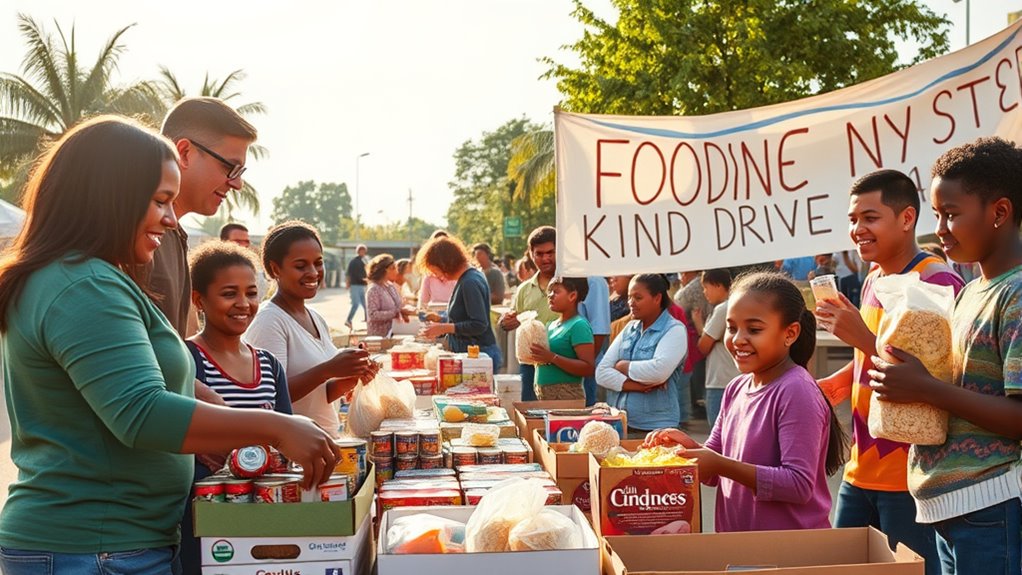Teaching compassion through local food drives helps you foster empathy, build community bonds, and teach social responsibility. By involving students in planning and reflecting on their efforts, you promote leadership, responsibility, and a greater understanding of food insecurity. These activities also encourage genuine connections and inspire ongoing kindness. If you continue exploring, you’ll discover practical ways to integrate these lessons into your classroom and create a lasting culture of compassion.
Key Takeaways
- Incorporate community service projects to foster empathy, teamwork, and cultural awareness among students.
- Use real stories and local data to highlight food insecurity and deepen students’ emotional understanding.
- Engage students in planning and leading food drives to build responsibility, leadership, and a sense of ownership.
- Promote reflection on personal experiences and community impact to nurture genuine compassion and emotional growth.
- Build strong local partnerships and ongoing initiatives to sustain kindness and create a culture of giving.
Understanding the Importance of Community Service

Community service plays a crucial role in fostering compassion and strengthening the bonds within your neighborhood. When you participate in local food drives, you develop essential volunteering skills like organization, teamwork, and communication, which are vital for effective service. It also broadens your cultural awareness as you encounter diverse community members and their unique stories. Understanding different backgrounds helps you become more empathetic and responsive to others’ needs. These experiences teach you the value of giving back and highlight how small actions can create meaningful change. By engaging in community service, you not only support those in need but also grow personally, gaining insight into the challenges others face. This foundation of compassion encourages ongoing involvement and builds a more connected, caring community.
Connecting Empathy With Real-World Experiences
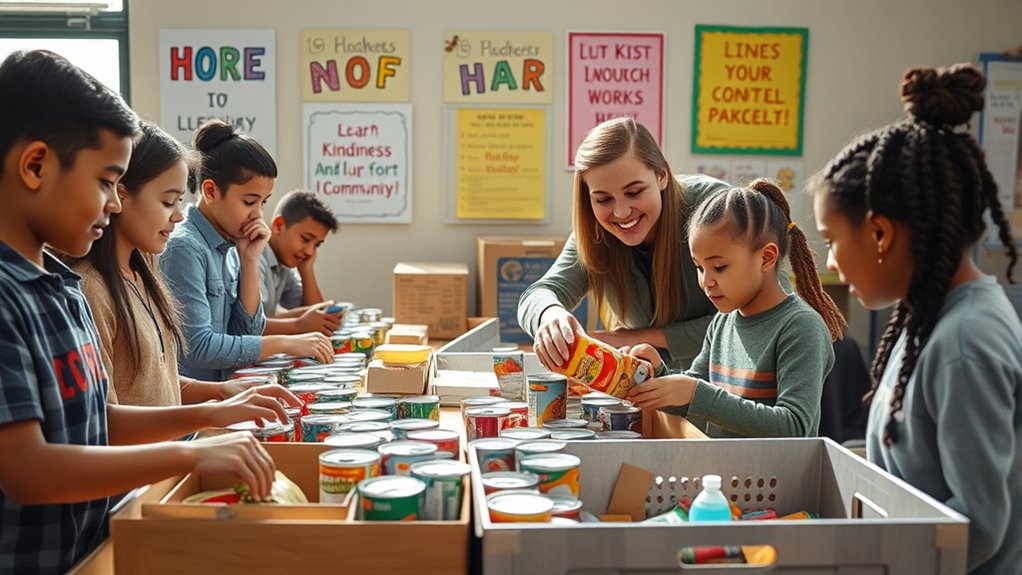
Connecting empathy with real-world experiences transforms understanding into meaningful action. When you encourage students to engage directly with those in need, you foster cultural awareness and deepen emotional intelligence. Through participating in local food drives, students see firsthand how different backgrounds influence people’s struggles, helping them develop a broader perspective. These experiences bridge the gap between theory and practice, making compassion tangible. As students interact with diverse community members, they learn to recognize emotions and respond thoughtfully, strengthening their empathy. This connection helps them understand that compassion isn’t just a feeling but an active commitment rooted in real-world understanding. Incorporating healthy eating habits into service projects can also promote overall well-being and resilience among participants. Ultimately, these experiences cultivate a sense of responsibility and a genuine desire to support others beyond the classroom.
Planning a Successful Food Drive With Students

To plan a successful food drive with students, start by clearly defining your goals and identifying the specific needs of the community. This sets a focused direction that boosts student motivation, as they see the tangible impact of their efforts. Encourage students to participate in goal setting, making the process collaborative and empowering them to take ownership. Break down tasks into manageable steps, such as collecting donations, spreading awareness, or organizing drop-off points. Celebrate small milestones to keep morale high. Clear communication is key—explain the purpose and how their contributions help others. Additionally, understanding the importance of projector image quality can inspire students to learn about supporting visual presentations during the event. By establishing clear objectives and involving students in planning, you foster a sense of purpose that motivates ongoing engagement and ensures the food drive’s success.
Teaching About Food Insecurity and Its Impact

Have you ever wondered how food insecurity affects individuals and families? Teaching about this issue helps build compassion and understanding. You can start by sharing hunger statistics to show how widespread the problem is, emphasizing that millions struggle to access enough nutritious food. Explain that food insecurity isn’t just about hunger—it also impacts nutrition awareness, leading to poor health and developmental challenges. Encourage students to contemplate the emotional and physical toll on those affected. Using real stories or local data can make the issue more relatable. By understanding the true impact of food insecurity, students develop empathy and a sense of urgency to help. Recognizing the importance of sound recording techniques and equipment can help in documenting stories that raise awareness. This foundation prepares them to actively participate in food drives and advocate for solutions that address both hunger and nutritional needs.
Encouraging Student Leadership and Responsibility
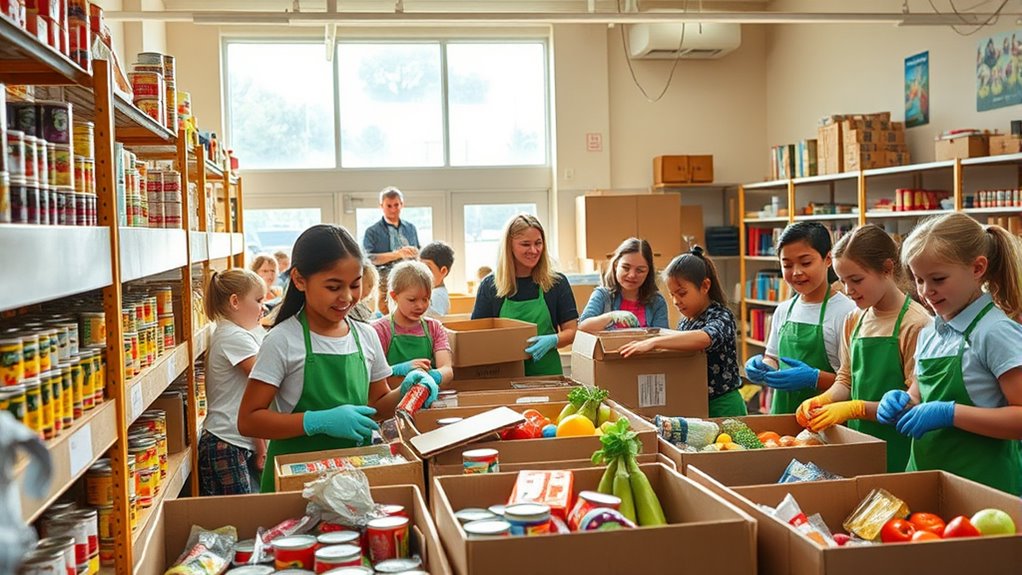
Empowering students to take on leadership roles in food drives fosters a sense of responsibility and community engagement. When students lead efforts, their motivation increases as they see the tangible impact of their actions. This encourages leadership development, helping them build skills like organization, communication, and problem-solving. To inspire student motivation and responsibility, consider these strategies: – Assign specific roles, such as organizing collection points or outreach coordinators – Encourage students to set personal goals for participation and outreach – Provide opportunities for reflection on leadership experiences and community impact Understanding leadership traits can further enhance their effectiveness in these roles.
Promoting Teamwork and Collaboration
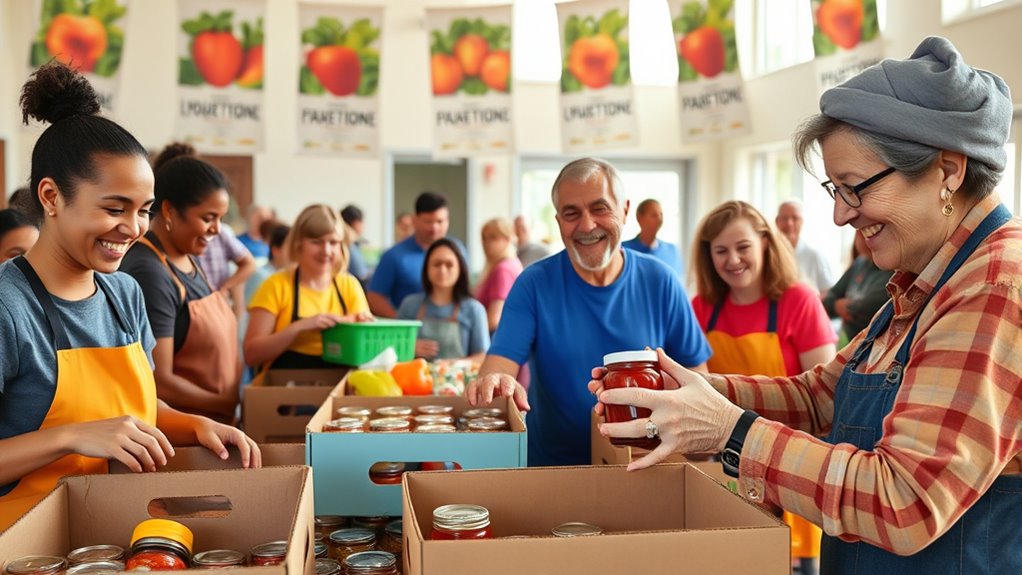
Promoting teamwork and collaboration is essential for the success of local food drives because working together amplifies efforts and fosters a sense of shared purpose. You can encourage peer mentorship, where experienced participants guide newcomers, building trust and strengthening the team. This not only streamlines tasks but also boosts morale. Creative collaboration allows team members to brainstorm innovative ways to reach more donors or organize efficient collection points. When everyone contributes their ideas and skills, the project becomes more dynamic and effective. By emphasizing teamwork, you help participants develop communication skills, empathy, and a sense of community. Additionally, understanding the cultural significance of community efforts can deepen participants’ commitment and respect for diverse perspectives. Ultimately, fostering collaboration transforms a simple drive into a meaningful experience, teaching valuable lessons about cooperation and collective impact.
Reflecting on the Impact of Giving

When you take time to reflect on your giving, you notice how it strengthens community bonds and creates a sense of unity. It also helps you see how your actions foster empathy and care in others. These reflections deepen your understanding of the true impact of kindness and generosity. Engaging in emotional well-being techniques can further enhance your capacity for compassion and connection.
Strengthening Community Bonds
Participating in local food drives creates immediate opportunities for community members to connect and work toward a common goal. When you contribute through food donation or help with volunteer coordination, you strengthen bonds that unite neighbors. These efforts foster trust and shared purpose, making the community more resilient. As you organize or donate, you see firsthand how collaboration builds relationships and encourages ongoing participation. Utilizing email marketing strategies can help promote these events and increase community involvement.
Cultivating Empathy and Care
Seeing the direct impact of your giving can deepen your sense of empathy and care for others. When you witness how your contributions help those in need, it becomes easier to understand their struggles and feel genuinely connected. Your involvement can also expand your awareness to issues like animal welfare and environmental activism, reminding you that compassion extends beyond humans. Supporting local food drives shows you how small actions can benefit vulnerable animals and protect natural resources. As you reflect on these effects, your empathy grows stronger, inspiring ongoing kindness and responsibility. This process helps you recognize the interconnectedness of community, environment, and well-being, fostering a deeper sense of care that motivates continued giving and active engagement. Practicing spiritual energy awareness during your acts of kindness can amplify your compassionate intentions and deepen your emotional connection to the impact you create.
Incorporating Lessons of Compassion Into Class Discussions
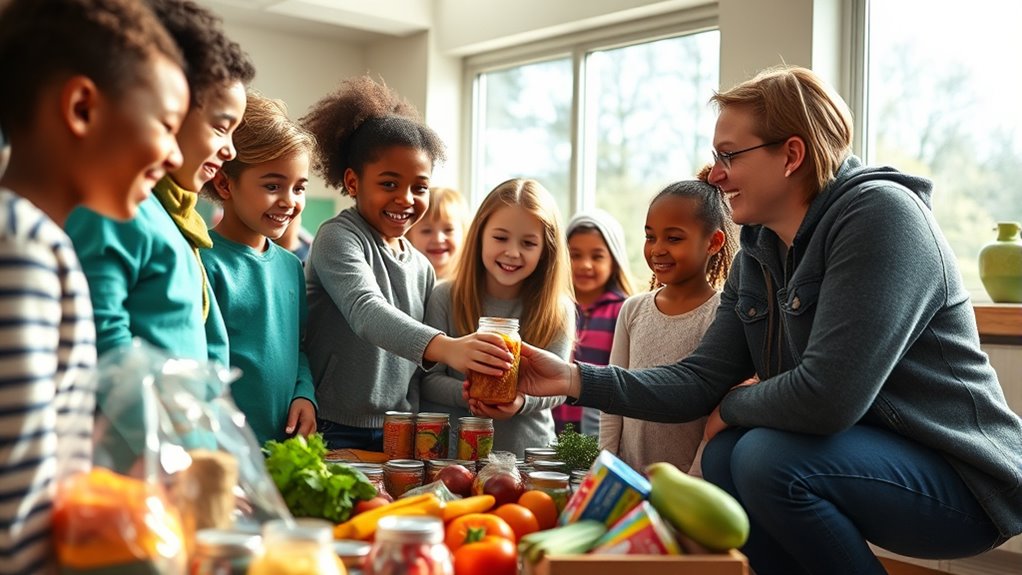
You can start by sharing personal stories that highlight acts of kindness, making the lessons more relatable. Then, discuss how community efforts, like food drives, create real impact and foster compassion. Finally, encourage empathy exercises to help students understand different perspectives and deepen their emotional connection. Incorporating awareness of skin protection can also help students recognize the importance of caring for others’ well-being.
Sharing Personal Stories
How can sharing personal stories enhance lessons of compassion in the classroom? When you encourage students to share their volunteer stories or memories of meal sharing, it personalizes the lesson. This creates emotional connections that foster empathy and understanding. Students see real-life examples of kindness, making compassion tangible. Listening to stories about helping others or overcoming challenges inspires students to act similarly. It also prompts reflection on their own experiences and values. To keep engagement high, consider using:
- Personal anecdotes from volunteers or students
- Stories that highlight acts of kindness during food drives
- Reflections on how sharing meals fosters community
- Recognizing the importance of payment data protection in safeguarding personal information during online donations
These stories deepen students’ awareness of compassion, making lessons more impactful and memorable.
Discussing Community Impact
Have you considered how classroom discussions can highlight the broader impact of community service? When you talk about volunteering opportunities, emphasize how these efforts benefit the entire community, not just individuals. Use real examples from local partnerships to show students how their actions contribute to positive change. Discuss how food drives help reduce hunger and strengthen neighborhood ties, making the impact tangible. Encourage students to reflect on the ripple effect of their participation, fostering a sense of responsibility and compassion. By connecting classroom lessons to community outcomes, you make the concept of service meaningful. This approach helps students see their role in creating a supportive, caring environment where everyone benefits from collective effort.
Encouraging Empathy Exercises
Building on the importance of community impact, incorporating empathy exercises into classroom discussions can deepen your students’ understanding of compassion. You can encourage mindful listening, prompting students to truly hear others’ perspectives without interrupting or judging. Developing emotional awareness helps students recognize and understand their own feelings while empathizing with classmates’ experiences. To make these exercises engaging:
- Use role-playing scenarios that reflect real-life community challenges
- Facilitate guided reflections on feelings experienced during discussions
- Incorporate storytelling to foster connection and understanding
These activities promote active engagement, deepen empathy, and help students connect lessons of compassion to their daily interactions. By focusing on mindful listening and emotional awareness, you create a classroom environment where empathy naturally flourishes.
Engaging Families and the Broader Community

What makes a food drive truly successful is the active involvement of families and the wider community. You can foster this by building strong local partnerships with schools, churches, and businesses. These partnerships help spread awareness and encourage participation. To keep everyone engaged, focus on volunteer coordination; assign clear roles, schedule shifts, and recognize contributions. When families see how their efforts directly impact neighbors, they’re more likely to stay involved and invite others to join. Hosting community events or informational sessions can also boost participation. By fostering collaboration with local organizations and ensuring volunteers feel valued and organized, you create a sense of shared purpose. This collective effort not only supplies food but also teaches compassion and unity within your community.
Sustaining a Culture of Kindness Beyond the Food Drive
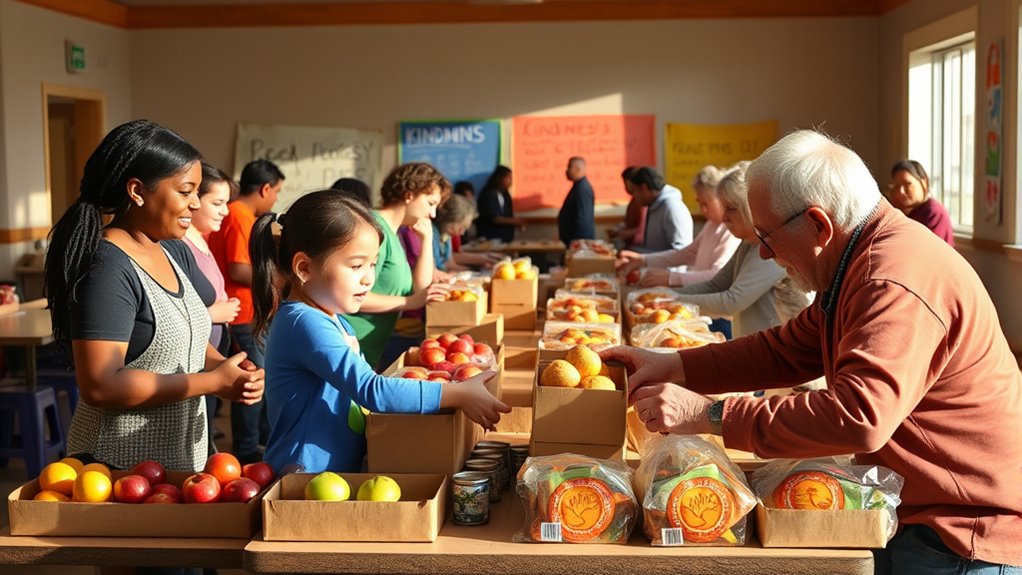
You can keep kindness alive by encouraging ongoing acts of generosity and community engagement. Building strong connections helps everyone feel more connected and invested in each other’s well-being. When you practice empathy daily, cultivating a lasting culture of compassion becomes a natural part of your community.
Fostering Long-Term Generosity
To cultivate a lasting culture of kindness, it’s essential to go beyond the immediate impact of a food drive and encourage ongoing generosity. You can do this by promoting volunteering opportunities that keep community members engaged year-round. Building strong charitable partnerships ensures continuous support and resource sharing, strengthening your efforts over time. Encourage individuals to make giving a habit rather than a one-time act, fostering a sense of ownership and empathy.
- Develop regular volunteer programs that extend beyond food drives
- Collaborate with local businesses to sustain charitable initiatives
- Share stories of long-term impact to inspire ongoing involvement
Building Community Connections
Building community connections is essential for maintaining a culture of kindness long after the food drive ends. By encouraging ongoing volunteer opportunities, you create sustained engagement that deepens relationships and fosters trust. Use innovative fundraising strategies to keep the momentum alive and show your community’s commitment. Consider partnering with local businesses or hosting events that reinforce shared values. To visualize this, think of your efforts as a table:
| Initiative | Impact | Next Steps |
|---|---|---|
| Volunteer opportunities | Builds trust and camaraderie | Plan regular volunteer days |
| Fundraising strategies | Sustains resources | Develop creative campaigns |
| Community partnerships | Strengthens bonds | Reach out to local organizations |
| Educational events | Raises awareness | Organize workshops |
| Recognition programs | Celebrates contributions | Highlight volunteer stories |
These efforts weave kindness into the fabric of your community, creating a lasting culture of compassion.
Cultivating Empathy Daily
While food drives are powerful moments for community action, cultivating empathy each day guarantees kindness becomes a lasting part of your culture. You can practice mindful listening by truly hearing others’ stories and needs, which deepens emotional awareness. This daily effort keeps compassion alive and encourages genuine connections. To sustain this mindset:
- Make time for conversations that foster understanding
- Reflect on your emotional responses and biases
- Offer support beyond the food drive, like volunteering or mentoring
Frequently Asked Questions
How Can Teachers Assess Students’ Understanding of Compassion Effectively?
When evaluating students’ understanding of compassion, you should focus on student reflection and empathy demonstrations. Encourage students to share personal stories or journal their thoughts, revealing their grasp of compassion. Observe their behavior during group activities and note how they demonstrate empathy toward others. Using rubrics that include these elements helps you gauge their emotional growth, ensuring they’re internalizing compassion beyond just theoretical knowledge.
What Are Some Creative Ways to Involve Reluctant Students in Food Drives?
To boost student engagement in food drives, you can involve reluctant students by creating fun, meaningful activities like themed collection days or friendly competitions. Partner with community organizations to give students real-world impact, making participation more appealing. Encourage them to share personal stories or ideas, fostering a sense of ownership. Building strong community partnerships helps demonstrate the importance of their contributions, inspiring even hesitant students to get involved and develop compassion.
How Can Food Drives Be Adapted for Different Age Groups?
You can adapt food drives for different age groups by designing age-appropriate activities that engage each group effectively. For younger kids, use colorful posters and simple tasks to boost participation, while teens might respond better to peer-led initiatives and social media challenges. Incorporate motivational strategies like recognizing contributions publicly or offering small rewards. Tailoring your approach guarantees everyone feels involved and motivated to support the cause.
What Challenges Might Schools Face When Organizing Local Food Drives?
Imagine you’re organizing a food drive at your school. You might face challenges like resource allocation, where you struggle to gather enough supplies or volunteers. Additionally, maintaining community engagement can be tough if students and families aren’t motivated or aware. These hurdles require careful planning, clear communication, and teamwork. Addressing resource needs and fostering a sense of community can help your food drive succeed and make a lasting impact.
How Can Success in Teaching Compassion Through Food Drives Be Measured?
When measuring empathy and community impact, you should look at both tangible and intangible results. Track the amount of food collected and donations received to gauge community support. Additionally, observe changes in student attitudes, participation levels, and conversations about compassion. Conduct surveys or reflection exercises to assess how the experience influences their understanding of others’ needs. Success is demonstrated by increased awareness, ongoing engagement, and stronger community bonds.
Conclusion
By teaching compassion through local food drives, you have the power to transform students into superheroes of kindness, capable of changing lives one act at a time. When you connect empathy with real-world action, you’re creating a ripple effect that can flood your entire community with generosity and understanding. Keep inspiring your students to give, lead, and reflect—because together, you’re building a world where kindness truly knows no limits.
